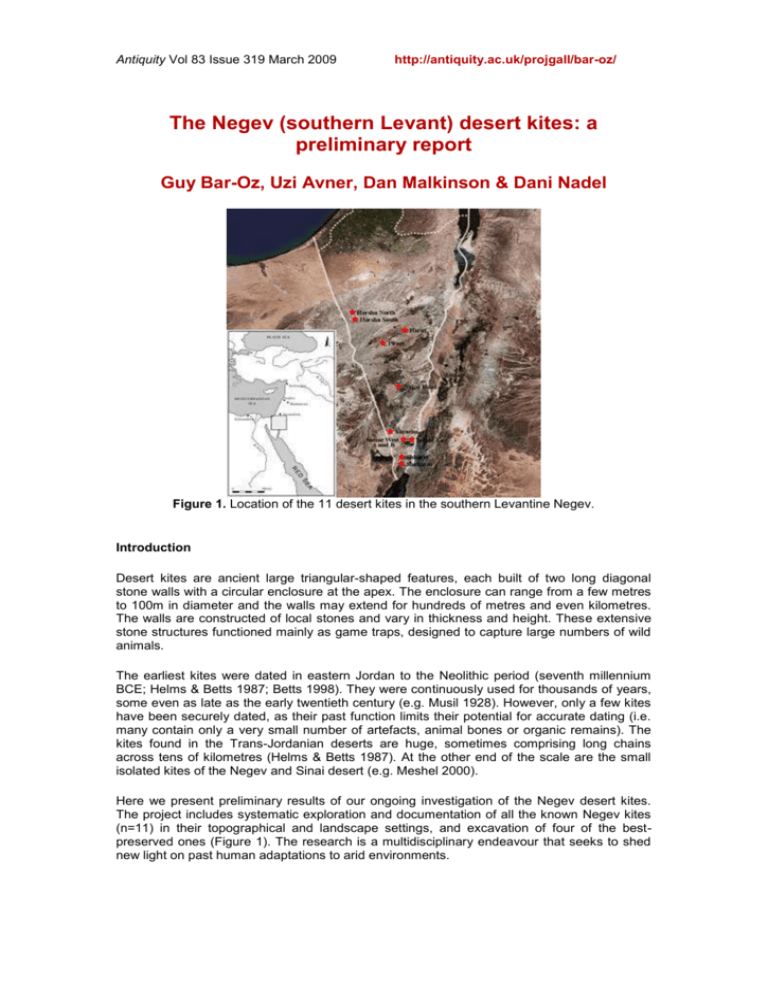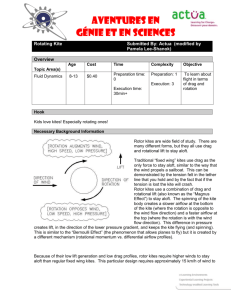Antiquity (Project
advertisement

Antiquity Vol 83 Issue 319 March 2009 http://antiquity.ac.uk/projgall/bar-oz/ The Negev (southern Levant) desert kites: a preliminary report Guy Bar-Oz, Uzi Avner, Dan Malkinson & Dani Nadel Figure 1. Location of the 11 desert kites in the southern Levantine Negev. Introduction Desert kites are ancient large triangular-shaped features, each built of two long diagonal stone walls with a circular enclosure at the apex. The enclosure can range from a few metres to 100m in diameter and the walls may extend for hundreds of metres and even kilometres. The walls are constructed of local stones and vary in thickness and height. These extensive stone structures functioned mainly as game traps, designed to capture large numbers of wild animals. The earliest kites were dated in eastern Jordan to the Neolithic period (seventh millennium BCE; Helms & Betts 1987; Betts 1998). They were continuously used for thousands of years, some even as late as the early twentieth century (e.g. Musil 1928). However, only a few kites have been securely dated, as their past function limits their potential for accurate dating (i.e. many contain only a very small number of artefacts, animal bones or organic remains). The kites found in the Trans-Jordanian deserts are huge, sometimes comprising long chains across tens of kilometres (Helms & Betts 1987). At the other end of the scale are the small isolated kites of the Negev and Sinai desert (e.g. Meshel 2000). Here we present preliminary results of our ongoing investigation of the Negev desert kites. The project includes systematic exploration and documentation of all the known Negev kites (n=11) in their topographical and landscape settings, and excavation of four of the bestpreserved ones (Figure 1). The research is a multidisciplinary endeavour that seeks to shed new light on past human adaptations to arid environments. The Negev desert kites All 11 Negev kites are located in carefully chosen, advantageous and strategic settings. The kites can be divided into two major groups according to their environmental locations. Some were built at the opening of rich pasture areas while others were constructed along ancient local migration routes of ungulates. The latter kites are isolated and located at topographic 'bottlenecks' or cliff edges in hilly environments (Figure 2). Among the kites near large pasture areas three are adjacent (e.g. the Samar Kites; Figure 3). Though on a much smaller scale, this group of kites is similar to the chain kites in Transjordan (e.g. Jawa and Dhuweila areas). Figure 2. Aerial view of the Nahal Eshel kite. Note the natural topographic drop of the cliff incorporated in the design of the kite and the construction of the enclosure (red arrow). The length of each wall is c. 100m (blue arrows mark the distal ends of the walls). . Figure 3. Aerial view of the adjacent Samar-West kites, A at the top and B at the bottom. Note that the two kites are almost connected like a 'W' (modern tracks cross the long walls). The locations of enclosures are marked by red arrows and blue arrows mark the distal ends of the walls. Figure 4. Microlithic flint lunates found during the excavation of the enclosure of Samar-West B kite. We excavated the apex of four kites from distinct ecological settings: two adjacent kites (Samar-West A and B in the southern Arava Valley), which were presumably used at the same time, and two isolated ones (Sayarim in a hilly area and Pitam in the Ramon Crater). The locations of these sites are given in Figure 1. An ancient tumulus was built on top of the entrance to the enclosure of Samar-West A. Radiocarbon dates of charcoal from within it indicate that it was built during first half of the third millennium BCE. At Samar East a fourththird-millennium dwelling compound was built on top of the kite's enclosure. Microlithic flint lunates found inside the enclosure of Samar-West B (Figure 4) are typical of fifth-fourthmillennium BCE cultures of this arid region. This new information, coupled with previous dating of additional Arava sites (based on 14C, OSL and Chalcolithic pottery) and Sinai kites (by 14C) manifest that the kites were constructed or used during the fifth-second millennia BCE. Further information could be gathered regarding the planning and construction of each kite. We found that in the Samar kites, which are constructed on a plane, a massive ramp was built to hide the enclosure from the driven game, creating a drop into the enclosure (Figure 5). Excavation of the ramp revealed that its construction also involved cutting into bedrock soils in order to create the necessary artificial 'topographic drop' at the apex of each trap. Most of the construction stones were brought from nearby, and some very large ones required significant efforts to move them (Figure 5). Figure 5. The built ramp of Samar-West B kite, hiding the enclosure from the driven game. Note the large boulders incorporated in the walls near the enclosure. Figure 6. Depiction of a kite in a rock-drawing from the southern Sinai (courtesy of I. Hershkovitz). It seems that some of the kites located along migration routes were used to trap small numbers of local herbivores, such as Dorcas gazelle (Gazella dorcas), onager (Equus hemionus) and Arabian oryx (Oryx leucoryx). The massive stone constructions documented in several kites indicate that they were designed to hunt large ungulates, such as onagers (Figure 6). Thus, it appears that species ecology and herd size are among the main causes that determined the location, size and construction of each kite. Acknowledgements We thank Tamar Orr-Gat, Reuven Yeshurun, Anna Avshalomov, Amnon Nahmias, David Hadash and other students for their assistance in fieldwork. We are warmly grateful to Assaf Holtzer and Hanan Ginat for their advice, and we thank the people of Kibutz Samar for their friendliness and hospitality. The research was generously supported by the National Geographic Society grant No. 8325-07. References BETTS, A.V.G. 1998. Dhuweilla: area survey, in A.V.G. Betts et al. (ed.) The Harra and the Hammad: excavations and surveys in Eastern Jordan: 191-205. Sheffield: Sheffield Academic Press. HELMS, S. & A.V.G. BETTS. 1987. The desert "kites" of the Badiyat Esh-Sham and North Arabia. Palיorient 13: 41-67. MESHEL, Z. 2000. Desert kites in Sinai and Southern Negev, in Z. Meshel (ed.) Sinai: excavations and studies (British Archaeological report International Series 876): 121-42. Oxford: Archaeopress. MUSIL, A. 1928. The manners and customs of the Rwala Beduins. New York: American Geographical Society. Authors (* Author for correspondence) Guy Bar-Oz* Zinman Institute of Archaeology, University of Haifa, Haifa 31905, Israel (Email: guybar@research.haifa.ac.il) Uzi Avner Ben-Gurion University & Arava Institute for Environmental Studies, Eilat 88133, Israel Dan Malkinson Department of Geography and Environmental Studies, University of Haifa, Haifa 31905, Israel Dani Nadel Zinman Institute of Archaeology, University of Haifa, Haifa 31905, Israel







